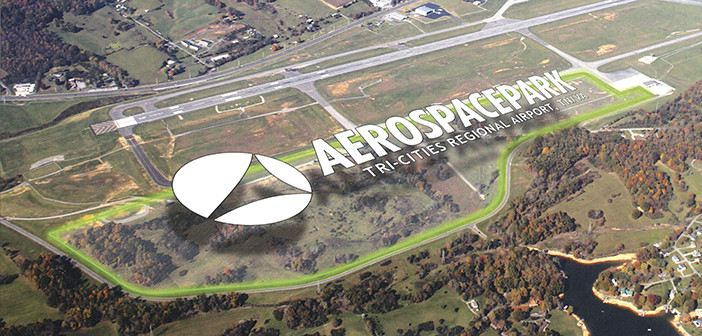By Gary Gray
Johnson City is now one of five local governments serving as co-signers for the Tri-Cities Airport Authority’s $8.5 million bond issuance, which will kick-start an estimated $18 million Aerospace Park project expected to bring thousands of jobs to the region.
“The Aerospace Park project is, without a doubt, the most important project in Northeast Tennessee,” said Johnson City Mayor David Tomita.“Not only from an economic standpoint, but also in terms of regional commitment. The citizens of each entity stand to benefit.”
City commissioners unanimously voted last week to guarantee about $1.9 million of the Airport Authority’s loan to help finance development of the new Aerospace Park on 160 acres adjacent to the airport.
Sullivan County approved its nearly $2.3 million share several weeks ago. Washington County is expected to vote on its $1.9 commitment in October, and Kingsport (about $1.6 million) and Bristol (about $795,000) will move on their commitments soon.
Officials from all entities agree it’s a good bet they will see a sizeable return on their investments. Site development, infrastructure, paving and utility construction paid for through the bonds will be used to entice and service aviation-related companies to create the region’s next burgeoning industry.
“The Airport Authority will be applying for a dollar-for-dollar matching grant from the state,” said City Manager Pete Peterson. “There’s been a lot of effort put into this. I think this is on the same level as the Wellmont Health System and Mountain States Health Alliance merger and the construction of the new East Tennessee State University Performing Arts Center. This potentially will create more than 1,500 jobs.”
Both houses of the General Assembly this spring unanimously approved a new law allowing the Tri-Cities Airport Authority to borrow money and issue revenue bonds. It also granted Washington and Sullivan counties, as well as Johnson City, Bristol and Kingsport the legal wherewithal to guarantee the principal and interest on the bonds will be paid in full.
“The park is probably the best economic opportunity the region has seen in a long time,” Peterson said. “While there has been talk of regional cooperation throughout the years, this project will demonstrate what can be done when five local governments work together.”
The Tri-Cities Airport Authority, Tennessee Valley Authority, Tennessee’s Economic and Community Development Department and NETWORKS — Sullivan Partnership are the primary marketers wanting to grow aerospace manufacturing and engineering at the site.
In the past 15 years, more than $23 million has been invested in infrastructure at the airport and for the park. The 2014 Hamilton Road relocation and taxiway extension accounts for more than $10 million.
Patrick Wilson, the airport’s executive director, said the first step is site development and that the main goal is to attract aircraft-related maintenance, repair and overhaul companies. There have been more than a dozen prospective projects tucked away awaiting legislative clearance, he added.
What makes these jobs desirable is that aircraft and avionics equipment mechanics and technicians have an average annual salary of about $58,400, while aerospace engineers make about $108,000 a year.
Meanwhile, median general manufacturing jobs in the Tri-Cities pay about $34,000 per year, according to the U.S. Bureau of Labor Statistics and Tennessee Department of Labor and Workforce Development.
The Airport Authority has been seeking money from a number of sources, including grants, such as the Tennessee Valley Authority and Federal Aviation Administration; allocations from the named local governments, as well as other state funding.
Other potential grant funding could come from the site development grants from the state’s Rural Economic Development Fund, U.S. Department of Commerce infrastructure improvement grants and the Appalachian Regional Commission.
“This truly appears to be one of those projects that is worth the investment,” said Commissioner Ralph Van Brocklin.
Commissioners also approved a proposal to give $500,000 to Hands On! Regional Museum in exchange for the museum’s downtown building at at 315 East Main St. — a move that would help complete relocation to the Gray Fossil Site & Museum and launch what would be known as the Hands On! Discovery Center.
Hands On! currently occupies three downtown buildings, but had owned only one — the main facility at 315 East Main St. It uses city-owned buildings at 313 and 317 East Main St. for storage, office space, field-trip staging and occasional exhibits.
“We feel like this is a win for everybody involved,” said Hands On! Executive Director Andy Marquart. “The timing of this first phase is critical for us.”
Marquart said the total cost to relocate and utilize about 12,000 square feet of space at the Gray Fossil Site and to begin the Discovery Center is about $1 million. He hopes to accomplish that by the middle of next year.
The next step is to construct a new, 22,000-square-foot facility (which includes 15,000 square feet of exhibition space) adjoining the fossil site building. This would bring to roughly 30,000 square feet the total amount of exhibition space. The cost for this phase is an estimated $6 million, and the goal is to begin construction in 2020.
Costs will be funded mainly through private donations, but there are other possible funding sources, such as federal and state grants.
“When the city has all three buildings, it will give them the capability to anchor further retail and commercial development downtown,” Marquart said. “The investment by the city in the new Discovery Center will have far-reaching and immediate value in regards to economic impact, education, tourism and quality of life.”
Hands On! was founded in 1986 and opened its doors for the first time in 1987. The Gray Fossil Site & Museum, at 1212 Suncrest Dr. in Gray, is home to East Tennessee State University’s Center for Excellence in Paleontology.




